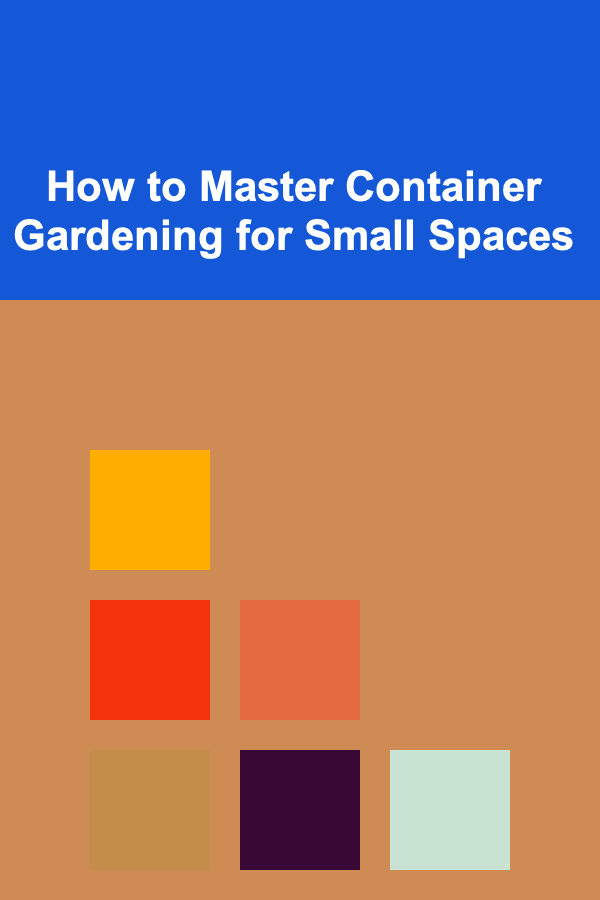
How to Master Container Gardening for Small Spaces
ebook include PDF & Audio bundle (Micro Guide)
$12.99$9.99
Limited Time Offer! Order within the next:

Container gardening is a fantastic way to grow plants in small spaces, whether you're living in an apartment, a townhouse, or just have limited outdoor space. It allows you to enjoy the benefits of gardening without the need for a large yard or a lot of ground space. With the right tools, knowledge, and planning, anyone can master container gardening and create a thriving garden in even the smallest of spaces.
This article will guide you through the process of mastering container gardening, from selecting the right containers to understanding plant care and troubleshooting common challenges. Whether you're growing vegetables, flowers, or herbs, container gardening can be a rewarding hobby that not only enhances the aesthetic appeal of your home but also provides fresh, home-grown produce.
Understanding the Basics of Container Gardening
Before you dive into container gardening, it's important to understand the basic principles that make it successful. Unlike traditional gardening, where plants are planted directly into the soil, container gardening involves growing plants in pots or other types of containers. These containers allow plants to have controlled environments, making it easier to regulate moisture, nutrients, and temperature.
Key Factors for Successful Container Gardening
- Container Size and Type: The size of your container matters, as it determines how much space the plant's roots will have to grow. Larger containers hold more soil and provide more room for root growth, which is important for plant health. You can choose from a variety of containers, such as plastic, ceramic, clay, or fabric pots. Each material has its benefits and drawbacks, which we'll discuss later.
- Drainage: Proper drainage is crucial for the health of your plants. Without drainage, water can accumulate at the bottom of the container, leading to root rot. Make sure your containers have drainage holes or use containers specifically designed for good water flow.
- Soil: Choose high-quality potting soil, not garden soil, as it's lighter and drains better. Potting soil is designed to provide the right balance of moisture retention, aeration, and nutrients. You can also add organic matter such as compost to enrich the soil.
- Watering: Plants in containers generally need more frequent watering than those planted in the ground because containers dry out faster. The key is to water deeply but infrequently, ensuring that water reaches the roots. Be mindful of the weather and adjust watering schedules accordingly.
- Light Requirements: Different plants have different light requirements, and container gardens are no exception. Assess the amount of sunlight your space receives during the day and choose plants accordingly. Some plants, like tomatoes and peppers, need full sun, while others, such as lettuce and spinach, thrive in partial shade.
Choosing the Right Containers for Small Spaces
When gardening in small spaces, selecting the right container is essential. The size, material, and style of the container all play a role in the success of your garden. Here's a breakdown of what to look for:
Size
The size of your container is crucial for the health of your plants. A container that's too small will restrict root growth, leading to stunted plants or poor yields. However, a container that's too large can make it harder to control moisture levels, and excess soil can retain too much water, which may cause root rot.
As a general rule of thumb:
- Small plants like herbs (basil, thyme, parsley) need containers that are at least 6--8 inches deep.
- Medium-sized plants (lettuce, radishes, peppers) require containers that are 10--12 inches deep and 12--14 inches wide.
- Larger plants (tomatoes, dwarf fruit trees) should have containers that are at least 18--24 inches deep.
If you're limited on space, you can opt for smaller containers or stackable options like vertical planters or hanging baskets. These make use of vertical space and don't take up much floor space.
Material
Different materials affect how much water and heat a container retains. Here are some common materials:
- Plastic: Lightweight and inexpensive, plastic containers retain moisture well and come in a variety of shapes and sizes. However, they may degrade over time under the sun's UV rays.
- Clay: Terra cotta pots are classic and provide excellent breathability, preventing roots from becoming waterlogged. However, they dry out faster than plastic pots, so they require more frequent watering.
- Ceramic: Similar to clay, but usually glazed. Ceramic containers are heavier and retain moisture well, but they can be more expensive.
- Fabric: Fabric pots, also known as grow bags, are breathable and allow roots to air prune, which promotes healthier root systems. They also retain moisture well and are lightweight and easy to store.
Design and Aesthetics
The visual appeal of your containers can enhance your outdoor or indoor space. With small spaces, choose containers that complement your home's style. Consider using coordinating colors or materials to create a cohesive look. Additionally, consider the placement of your containers. Hanging baskets, wall-mounted planters, and window boxes can make the most of limited space.
Selecting Plants for Container Gardening
When it comes to choosing plants for container gardening, the options are vast. However, not all plants are suited for container life. Some plants have deep, extensive root systems that need plenty of space to grow, while others are perfect for confined spaces.
Vegetables
Vegetable gardening is one of the most popular types of container gardening, especially for those who want fresh, home-grown produce. When selecting vegetables for small spaces, consider plants that have compact root systems and can thrive in containers:
- Tomatoes (dwarf or determinate varieties)
- Lettuce
- Spinach
- Herbs (basil, thyme, mint, oregano)
- Peppers
- Radishes
Flowers
Flower gardening can also be done in containers, which is an excellent way to add color and vibrancy to your space. Choose flowers that can thrive in pots:
- Petunias
- Geraniums
- Marigolds
- Begonias
- Pansies
- Snapdragons
Herbs
Herbs are perfect for container gardening because they typically have shallow root systems and don't require a lot of space to thrive. Growing herbs in containers is especially convenient for small spaces, as they can be placed on windowsills, balconies, or patios. Some easy-to-grow herbs include:
- Basil
- Mint
- Chives
- Parsley
- Rosemary
- Cilantro
Fruits
Fruits like strawberries, blueberries, and dwarf fruit trees can also be grown in containers. Dwarf varieties are especially suitable for small spaces because they are compact and can be grown in pots, hanging baskets, or small raised beds.
- Strawberries
- Dwarf apples
- Blueberries
- Lemon trees
- Raspberries
Planting and Care
Preparing the Container
Once you've selected your container and plants, it's time to start planting. Begin by ensuring that your container has proper drainage. If not, you can create drainage holes using a drill or by placing rocks at the bottom of the container.
Next, fill your container with the appropriate soil, leaving enough space at the top for watering. If you're growing vegetables or herbs, you might want to mix the potting soil with compost or slow-release fertilizers to provide extra nutrients for your plants.
Planting
When planting, ensure that you give each plant enough space to grow. Overcrowding plants in a small container can lead to poor airflow, stunted growth, and disease. Follow the spacing guidelines on the seed packets or plant labels to ensure your plants have enough room to thrive.
If you're growing plants from seeds, be sure to follow the specific instructions on the seed packet. Some seeds need to be started indoors before transplanting them into containers, while others can be directly sown into the pots.
Maintenance
Maintaining your container garden involves regular tasks like watering, pruning, fertilizing, and pest control.
- Watering: Water your plants early in the morning or late in the evening to avoid evaporation. Ensure that the water reaches the roots and doesn't just wet the surface.
- Fertilizing: Use a balanced, slow-release fertilizer to provide consistent nutrients throughout the growing season. If you're using a liquid fertilizer, dilute it as directed to avoid over-fertilizing.
- Pruning: Regular pruning helps remove dead leaves and encourages healthy growth. Some plants, like tomatoes, also benefit from removing suckers (small shoots growing in the leaf axils).
- Pest Control: Inspect your plants regularly for pests, such as aphids or spider mites. Use natural pest control methods like neem oil or insecticidal soap to manage infestations without harming your plants.
Troubleshooting Common Container Gardening Problems
While container gardening is rewarding, it can come with its challenges. Here are some common problems you may encounter and how to address them:
Overwatering or Underwatering
Overwatering can lead to root rot, while underwatering can stress the plants and cause wilting. To avoid these issues, make sure your containers have adequate drainage, and water deeply but infrequently.
Yellowing Leaves
Yellowing leaves can be caused by a variety of factors, including nutrient deficiencies, overwatering, or pests. Check for signs of pests, adjust watering practices, and ensure your plants are getting enough nutrients.
Root Rot
Root rot occurs when water sits at the bottom of the container for too long, causing the roots to decay. To prevent this, always ensure that your containers have proper drainage and don't let water accumulate in the saucer beneath the pot.
Leggy Growth
If your plants are stretching toward the light and looking leggy, they may not be getting enough sunlight. Move them to a sunnier location or use supplemental grow lights to ensure they receive the necessary light.
Conclusion
Container gardening is a wonderful way to grow plants in small spaces, and it's accessible to anyone, regardless of experience. With careful planning and attention to detail, you can create a thriving garden that enhances the beauty and productivity of your living space. By choosing the right containers, selecting appropriate plants, and providing the necessary care, you'll be able to master container gardening and enjoy fresh, home-grown produce or vibrant flowers all year long. Happy gardening!
Reading More From Our Other Websites
- [Home Staging 101] How to Stage Your Home for an Open House Event
- [Home Staging 101] Best Ways to Stage Your Home for Maximum Appeal and Saleability
- [Organization Tip 101] How to Organize Your Guest List for Easy Tracking
- [Gardening 101] 10 Easy Herbs to Grow Year‑Round on Your Kitchen Windowsill
- [Rock Climbing Tip 101] Best Double‑Damaged Tape Techniques for Preventing Finger Pulley Injuries
- [Organization Tip 101] How to Organize Your Car for Business Professionals
- [Personal Investment 101] How to Rebalance Your Investment Portfolio Regularly
- [Beachcombing Tip 101] From Hobbyist to Collector: Steps to Safely Find and Retrieve Amber Finds
- [Home Space Saving 101] How to Organize Your Home Office to Maximize Space and Productivity
- [Home Budget Decorating 101] How to Decorate Your Home With Salvaged Treasures: A Beginner's Guide

How to Evaluate the Impact of Inflation on Your Investments
Read More
How to Handle Returns and Damaged Goods in Your Inventory System
Read More
How to Set Realistic Deadlines to Reduce Stress
Read More
Optimizing Online Retail: Strategies for Growth and Success in E-commerce
Read More
How To Build a Strong Content Niche
Read More
How to Organize Your Errands by Location & Time
Read MoreOther Products

How to Evaluate the Impact of Inflation on Your Investments
Read More
How to Handle Returns and Damaged Goods in Your Inventory System
Read More
How to Set Realistic Deadlines to Reduce Stress
Read More
Optimizing Online Retail: Strategies for Growth and Success in E-commerce
Read More
How To Build a Strong Content Niche
Read More